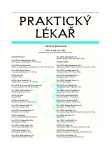Spontaneous intracranial hypotension
Authors:
A. Kopal 1; E. Ehler 1; M. Mrklovský 2
Authors‘ workplace:
Pardubická krajská nemocnice, Pardubice
Neurologická klinika
Přednosta: doc. MUDr. Edvard Ehler, CSc.
1; Multiscan, Radiologické centrum Pardubice
Vedoucí: prim. MUDr. Dušan Spitzer
2
Published in:
Prakt. Lék. 2010; 90(8): 486-489
Category:
Case Report
Overview
Spontaneous intracranial hypotension is often the cause of a new daily persistent headache, predominantly in younger and middle-aged patients. This clinical condition is characterized by a typical triad: orthostatic headache, low spinal cerebrospinal fluid pressure and typical cranial magnetic resonance imaging findings. Headaches are accompanied by other symptoms: nausea, vomiting, photophobia, stiffness or aches in the cervical spine are commonly seen. Dizziness, diplopia and hearing disturbances are also frequent. The typical clinical picture with characteristic cranial magnetic resonance imaging and low spinal cerebrospinal fluid pressure denotes spontaneous intracranial hypotension. Treatment consists of bed rest, sufficient intake of fluids, the administration of caffeine, and corticosteroid medication. If conservative treatment is ineffective, the placement of 1 or more lumbar epidural blood patches is indicated. The authors present the case report of a 54-year-old female who had developed intracranial hypotension syndrome, with typical cranial magnetic resonance imaging, which was resolved through successful non-invasive therapy.
Key words:
spontaneous intracranial hypotension, intracranial hypotension syndrome, low spinal cerebrospinal fluid pressure.
Sources
1. Schievink, W.I. Misdiagnosis of spontaneous intracranial hypotension. Arch. Neurol. 2003, 60, p. 1713-1718.
2. Schwedt, T.J., Dodick, D.W. Spontaneous intracranial hypotension. Curr. Pain. Headache Rep. 2007 Feb., 11(1), p. 56-61.
3. Ferrante, E., Savinono, A., Sances, G. et al. Spontaneous intracranial hypotension syndrome: report of twelve cases. Headache 2004, 44(6), p. 615-622.
4. Gordon, N. Spontaneous intracranial hypotension. Dev. Med. Child. Neurol. 2009, 51(12), p. 932-935.
5. Mea, E., Savoiardo, M., Chiapparini, L. et al. Headache and spontaneous low cerebrospinal fluid pressure syndrome. Neurol. Sci. 2007, 28, S232-S234.
6. Schievink, W.I. Spontaneous spinal cerebrospinal fluid leaks and intracranial hypotension. JAMA 2006, 295, p. 2286-2296.
7. Schievink, W.I., Maya, M.M., Louy, C., Moser, F.G., Tourje, J. Diagnostic criteria for spontaneous spinal CSF leaks and intracranial hypotension. AJNR Am. J. Neuroradiol. 2008, 29, p. 853-856.
8. Mokri, B. Spontaneous intracranial hypotension. Curr. Neurol. Neurosci. Rep. 2001, 1(2), p. 109-117.
9. Schievink, W.I. Spontaneous spinal cerebrospinal fluid leaks. Cephalalgia 2008,28(12), p. 1345-1356.
10. Schoffer, K.L., Benstead, T.J., Grant, I. Spontaneous intracranial hypotension in the absence of magnetic resonance imaging abnormalities. Can. J. Neurol. Sci. 2002, 29(3) p. 253-257.
11. Spelle, L., Boulin, A., Tainturier, C. et al. Neuroimaging features of spontaneous intracranial hypotension. Neuroradiology 2001, 43(8) p. 622-627.
12. Novotny, C. Pötzi, C., Asenbaum, S. et al. SPECT/CT fusion imaging in radionuclide cisternography for localization of liquor leakage sites. J. Neuroimaging 2009,19(3), p. 227-234.
13. Gandhi, D., Goyal, M., Miller, W., Covert, S. Answer to case of the month 88. Spontaneous intracranial hypotension. Can. Assoc. Radiol. J. 2003,54(2), p.126-128.
14. Shima, K., Ishihara, S., Tomura, S. Pathophysiology and diagnosis of spontaneous intracranial hypotension. Acta Neurochir. Suppl. 2008,102, p. 153-156.
Labels
General practitioner for children and adolescents General practitioner for adultsArticle was published in
General Practitioner

2010 Issue 8
- Memantine Eases Daily Life for Patients and Caregivers
- Metamizole vs. Tramadol in Postoperative Analgesia
- Metamizole at a Glance and in Practice – Effective Non-Opioid Analgesic for All Ages
- Memantine in Dementia Therapy – Current Findings and Possible Future Applications
- What Effect Can Be Expected from Limosilactobacillus reuteri in Mucositis and Peri-Implantitis?
Most read in this issue
- Spontaneous intracranial hypotension
- Human biomonitoring – its importance and application for evaluating population exposure to environmental chemicals (toxins)
- Zinc and its relation to prostate tumours
- Physical activity as a part of cardiovascular disease prevention in the general practitioner’s surgery
